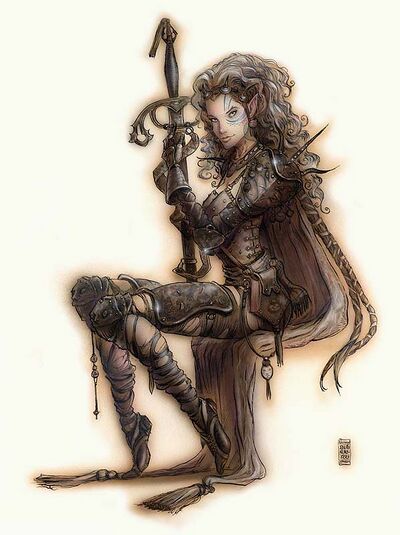Aasimar: Difference between revisions
No edit summary |
(Corrected one instance of "Assimar" to "Aasimar") |
||
| Line 1: | Line 1: | ||
[[File:Aasimar.jpg|400px|thumb|right|An | [[File:Aasimar.jpg|400px|thumb|right|An Aasimar as according to [[Tony DiTerlizzi]].]] | ||
Aasimar are a player character race in [[Dungeons & Dragons]] editions 2, 3, 3.5, and 5 (via the DMG) and in [[Pathfinder]]. They are counterparts to [[Tiefling]]s and [[Genasi]], being mortals who bear the blood of Celestials - the residents of the Upper Planes - in their lineage. | Aasimar are a player character race in [[Dungeons & Dragons]] editions 2, 3, 3.5, and 5 (via the DMG) and in [[Pathfinder]]. They are counterparts to [[Tiefling]]s and [[Genasi]], being mortals who bear the blood of Celestials - the residents of the Upper Planes - in their lineage. | ||
Revision as of 02:37, 21 November 2015

Aasimar are a player character race in Dungeons & Dragons editions 2, 3, 3.5, and 5 (via the DMG) and in Pathfinder. They are counterparts to Tieflings and Genasi, being mortals who bear the blood of Celestials - the residents of the Upper Planes - in their lineage.
Aasimar originated in the Planescape setting, as with their counterparts. Like the genasi, though, they came after the setting was initially released; the corebook for Planescape introduced only the tiefling, githzerai, and bariaur races. Instead, Aasimar had to wait until the Planeswalker's Handbook to get their first entry into the D&D world as a playable race. Aasimar are basically tailor made for people who want to play the various Good branches of the Alignment tree, especially as Clerics or Paladins, since they literally have living good in their veins, though, as with tieflings, playing around with the concept was popular.
Unlike tieflings, aasimar variability wasn't given a lot of attention. There was some afterthought mentioning of alternate stat bonuses and spell-like abilities in lieu of resistances, but it wasn't until "Warriors of Heaven" that they got similar diversity charts to the tieflings.
In 4e, aasimar never made it over. Instead, they got replaced with devas, former angels banished or voluntarily departed from the Astral Sea to live amongst mortals. The explanation given was that having three races who all shared the same basic origin of "a horny Outer Planar decided to get itself some sweet Prime Worlder poontang" was a little silly, and reeked of gridfilling - the "we have X already, so we need Y and Z to contrast it". So 4e played around with the ideas; the basic idea of "being touched by good/evil/the elements" remains intact, but "cursed descendant of an empire that swore pacts with devils", "angel that abandoned heaven for the mortal world" and "escaped slave-race from the Elemental Chaos" are all pretty different origins.
In Pathfinder, it's noted that a lot of Aasimar actually tend to go evil either because superstitious yokels tend to pile on emotional trauma and guilt until they snap by constantly harassing them for "blessings" that the aasimar can't actually give, or because they realize everyone automatically expects them to be capital-G Good Guys/Girls and so they can easily manipulate people. This is yet another way in which Pathfinder likes to present itself as the GrimDark D&D equivalent setting. They can have lots of different possible starting types, depending on which kind of celestial they descended from. Interestingly, supplements explicitly encourage white-hot holy-on-unholy action by stressing the odd sense of kinship most aasimar feel for their similarly-bullshit-cultural-expectation-wracked fiend-blooded counterparts. Naturally, the Pathfinder Aasimar sourcebook, "Blood of Angels" follows the same plans as the Tiefling sourcebook "Blood of Fiends", giving a D100 table for alternative traits to replace the vanilla aasimar's spell-like ability, and racial variants for aasimar recognizably tied to one of the existing celestial races - Agathions, Angels, Archons, Azata, Garudas and Peris.
Aasimar returned to 5e in the DMG as the sample race for showcasing the "build a race" rules. They're basically Tieflings flipped to a more Celestial aspect, complete with sharing the same +1 Mental Stat (Wisdom, for Aasimar) +2 Charisma bonus, Darkvision, Damage Resistance (Necrotic + Radiant) and spell-like abilities at level 1 (Lights), 3 (Lesser Restoration) and 5 (Daylight) format. They were recently voted one of the three most-popular races for a new D&D expansion to create in detail, with Mike Mearls professing they were his favorite race and that he really wanted to do them right because, in his own words, there's a tendency to make the good guys boring.